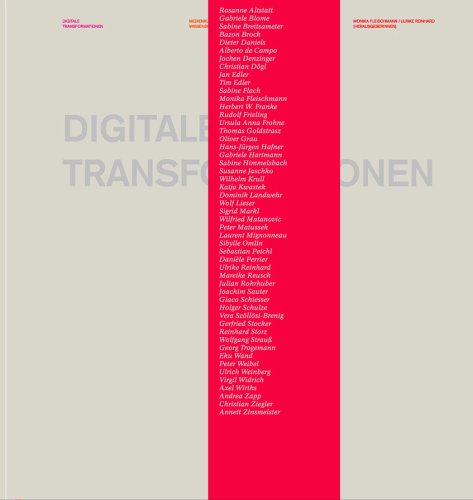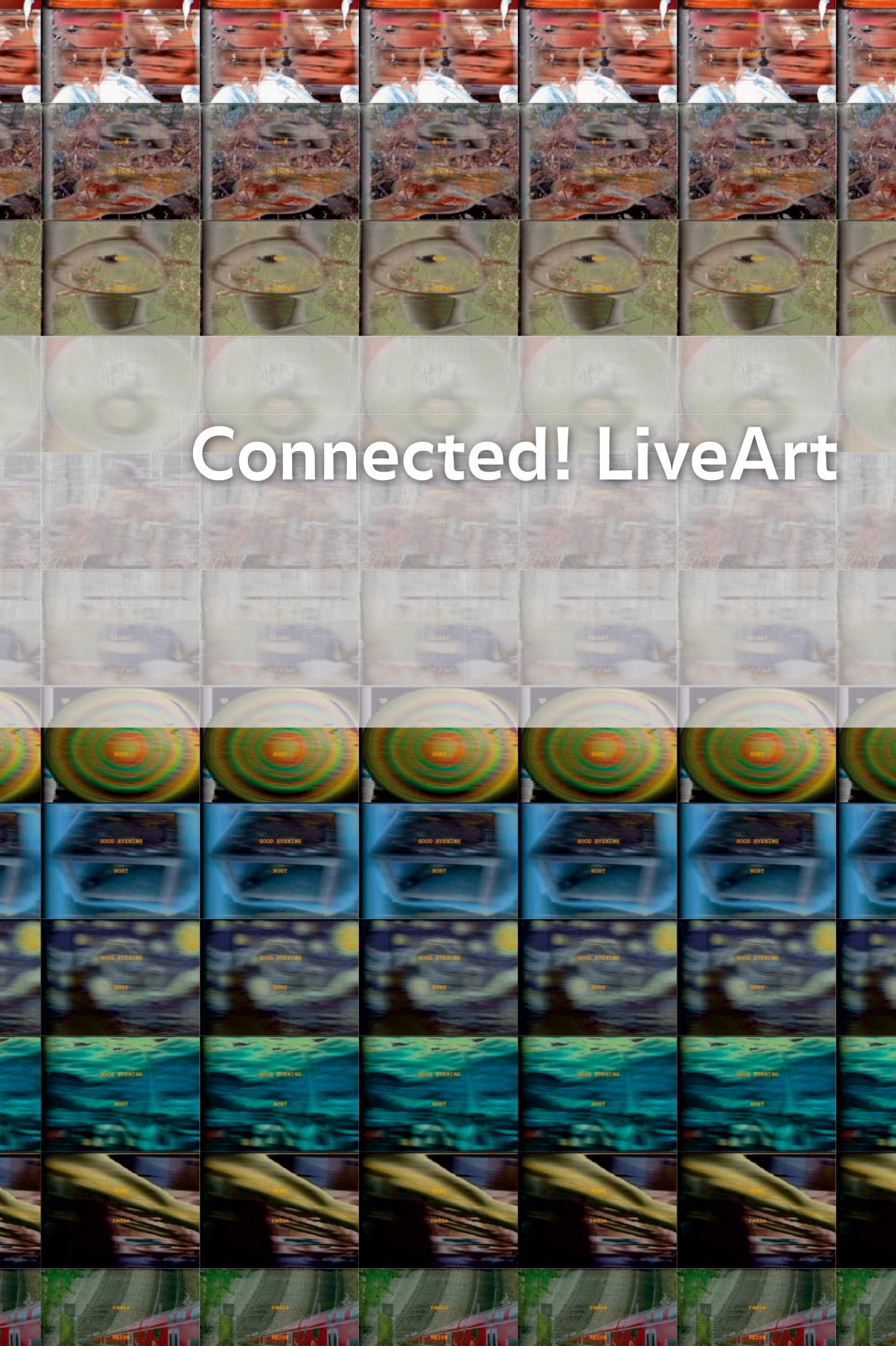Monika Fleischmann, Ulrike Reinhard (eds.): Digitale Transformationen: Medienkunst als Schnittstelle von Kunst, Wissenschaft, Wirtschaft und Gesellschaft (2004) [German]
Filed under book | Tags: · digital art, interface, media art

“Die Publikation Digitale Transformationen beschäftigt sich mit den grundlegenden Transformationen, welche die Kunst und das moderne Leben durch digitale Technologien erfahren. Theoretiker, Künstler und Wissenschaftler kommen neben Produzenten, Förderern und Vermittlern zu Wort, um die digitalen Transformationen in ihren vielfältigen Rollen und an konkreten Beispielen als neue Ästhetik und als Innovationsforschung vorzustellen. In der Kunst mit Informationstechnologien geht es um Bild(er-)findungen auf der Grundlage kommunikativer Prozesse, um begriffliche Strategien und kognitive Methoden. Damit möchten die Herausgeberinnen Ulrike Reinhard und » Monika Fleischmann nicht nur den klassischen Kulturbereich ansprechen, sondern die Medienkunst als künstlerische Position an der Schnittstelle von Technologie, Wirtschaft, Wissenschaft und Kultur denen nahe bringen, die bereit sind, diese Kunstform als einen wichtigen Schlüsselfaktor für neues Denken und Innovation anzuerkennen und zu fördern. Medienkunst zeigt neue Weltbilder. Sie zeigt, wie wir verstehen, was wir sehen und hören. Die Texte geben einen Einblick in Diskurs und Praxis im deutschsprachigen Raum und sind hier nachzulesen.”
Authoren: Rosanne Altstatt, Gabriele Blome & Jochen Denzinger, Sabine Breitsameter, Bazon Brock, Dieter Daniels & Rudolf Frieling, Alberto de Campo & Julian Rohrhuber, Christian Dögl, Jan & Tim Edler, Sabine Flach, Monika Fleischmann 1, Monika Fleischmann 2, Monika Fleischmann & Wolfgang Strauss, Herbert W. Franke, Ursula Frohne, Thomas Goldstrasz, Oliver Grau, Hans-Jürgen Hafner, Gabriele Hartmann, Sabine Himmelsbach, Susanne Jaschko, Wilhelm Krull und Vera Szöllösi-Brenig, Katja Kwastek, Dominik Landwehr, Wolf Lieser, Sigrid Markl & Virgil Widrich, Wilfried Matanovic, Peter Matussek, Laurent Mignonneau & Christa Sommerer, Sibylle Omlin, Sebastian Peichl, Danièle Perrier, Ulrike Reinhard, Mareike Reusch, Joachim Sauter, Giaco Schiesser, Holger Schulze, Gerfried Stocker, Reinhard Storz, Georg Trogemann, Eku Wand, Peter Weibel, Ulrich Weinberg, Axel Wirths, Andrea Zapp, Christian Ziegler, Annett Zinsmeister
Publisher Netzspannung.org, Heidelberg, 2004
ISBN 3934013384
369 pages
Publisher (archived)
PDF (95 MB, updated on 2019-10-13)
Comment (0)Sher Doruff: The Translocal Event and the Polyrhythmic Diagram (2006)
Filed under thesis | Tags: · aesthetics, art, collaboration, composition, digital art, emergence, media art, network art, performance, software, translocal performance
This thesis identifies and analyses the key creative protocols in translocal performance practice, and ends with suggestions for new forms of transversal live and mediated performance practice, informed by theory. It argues that ontologies of emergence in dynamic systems nourish contemporary practice in the digital arts. Feedback in self-organised, recursive systems and organisms elicit change, and change transforms. The arguments trace concepts from chaos and complexity theory to virtual multiplicity, relationality, intuition and individuation (in the work of Bergson, Deleuze, Guattari, Simondon, Massumi, and other process theorists). It then examines the intersection of methodologies in philosophy, science and art and the radical contingencies implicit in the technicity of real-time, collaborative composition. Simultaneous forces or tendencies such as perception/memory, content/expression and instinct/intellect produce composites (experience, meaning, and intuition- respectively) that affect the sensation of interplay. The translocal event is itself a diagram – an interstice between the forces of the local and the global, between the tendencies of the individual and the collective. The translocal is a point of reference for exploring the distribution of affect, parameters of control and emergent aesthetics. Translocal interplay, enabled by digital technologies and network protocols, is ontogenetic and autopoietic; diagrammatic and synaesthetic; intuitive and transductive. KeyWorx is a software application developed for real-time, distributed, multimodal media processing. As a technological tool created by artists, KeyWorx supports this intuitive type of creative experience: a real-time, translocal “jamming” that transduces the lived experience of a “biogram,” a synaesthetic hinge-dimension. The emerging aesthetics are processual – intuitive, diagrammatic and transversal.
Doctor of Philosophy, SMARTlab Programme in Performative New Media Arts, Central Saint Martins College of Art & Design, University of the Arts, London
288 pages
PDF
PDF (Appendix “The KeyWorx Interviews: Transcripts of Interviews and Conversations with KeyWorx Artists”)
Sher Doruff, Nancy Mauro-Flude (eds.): Connected: LiveArt (2005)
Filed under catalogue | Tags: · art, collaboration, installation art, media art, network art, networks, radio art, sound art, streaming, telepresence

“The Connected! Programme spanned a two year period from January 2003 to January 2005. It officially concluded with a celebratory Birthday party for Art in the Theatrum Anatomicum of Waag Society, the local ‘home’-base of many Connected! projects. Although most of the people present at that event agreed with Federico Bonelli’s assessment “that art could have committed suicide in 1984″ – the research and the show goes on.
The Connected! Programme had four nested components: Projects, Artists-in-Residence, Sentient Creatures Lecture Series and Anatomic. This book documents many of the activities in these domains; the lectures, the events, the workshops, the performances, the installations, the discourse. Yet, it’s interesting to note that pulling together material for this publication was a bit like trying to capture the wind. Much of the work produced in this two-year period emphasized the real-time process of the making. Documentation of that often fragile, unstable and always already ephemeral process is sketchy at best and marginal to the actualization of the event itself. For many of these artists, documentation is a secondary concern, an afterthought. For others, documenting is an integral process indistinguishable from the event itself.
There are myriad photos in this catalogue of artists behind their laptops. Myriad photos that say little about the levels and layers of codified communication emitted from those unseen screens. These casual, unpretentious shots are images of social networks in progress – the translocal – a feedback loop of the local effecting the global affecting the local affecting the global. Not only does the artwork produced, or better transduced, scramble representational meaning but so too does the process of making. Performance practice that addresses the indeterminate dance-on-the-edge-of-chaos in compositional processes is a felt thing, an experience that doesn’t always translate well in laptop snapshots.”
Co-writers: Federico Bonelli, Beth Coleman, Josephine Dorado, Lucas Evers, Wander Eikelboom, Howard Goldkrand, Jan-Kees van Kampen, Arjen Keesmaat, Jeff Mann, Mark Meadows, Hellen Sky, Michelle Teran, Ananya Vajpeyi
Publisher Waag Society, Amsterdam, September 2005
Creative Commons BY-SA 2.0 Netherlands License
160 pages
PDF (updated on 2012-9-3)
Comment (0)
